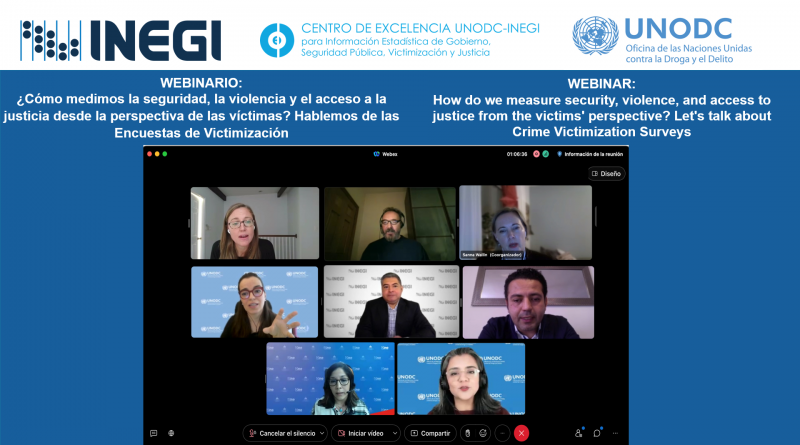National Victimization Surveys respond to new challenges of information on security and justice
The Webinar “How do we measure security, violence and access to justice from the victims’ perspective? Let’s talk about Victimization Surveys” was held on December 2. Sponsored by the UNODC-INEGI Center of Excellence (CoE) and the National Institute of Statistics and Geography (INEGI) of Mexico, the webinar presented the implementation experiences of six of the main national victimization surveys in the world: United States, United Kingdom, Sweden, Mexico, Colombia and Dominican Republic. The experts shared their most recent innovations to generate relevant data on security, victimization and access to justice with quality, representativeness and comparably.
Heather Brotsos, Chief, Victimization Statistics, U.S. Bureau of Justice Statistics (BJS) showed the 50-year history of the National Victimization Survey (NCVS) and highlighted the recent addition of measuring hate crime and youth victimization. He shared the redesign process to revise its crime concepts, to evaluate police performance and to use data collection methods that adapt to current technologies to achieve more cost-efficient data collection.
Subsequently, Joseph Traynor of the Crime, Income and Wealth Division of the Office for National Statistics (ONS) of England and Wales noted that the Crime Survey for England and Wales (CSEW) is undergoing its most radical change in the last 40 years, which is due to the COVID-19 pandemic and new government policy requirements. On the one hand, it is facing a transformation from a face-to-face survey to a telephone survey in a panel format. Another change responds to the “Levelling Up” policy, a UK initiative to create safer neighborhoods to live in by 2030, which requires local representativeness to reach out especially to neighborhoods with the highest crime problems. In view of this, a new sampling strategy is being developed with a focus on targeting key areas and comparability for monitoring. Thus, the CSEW provides guidelines on how to collaborate in the evaluation of public security policies at the local level, while reducing costs.
Following this point of view, Sanna Wallin, senior researcher at the Swedish National Council for Crime Prevention (Brä), mentioned that the Swedish Crime Survey (SCS), faced with the problems of increasing non-response, costs and the need for greater detail on the crimes investigated, the SCS moved from a purely telephone survey to one based on an online and postal questionnaire with telephone follow-up, in addition to increasing the sample, the number of crimes investigated, broadening the age range of respondents and increasing the geographic breakdown. This has made the Swedish survey more robust, detailed and representative of the Swedish reality.
For Mexico, Mario Alberto Santillana, Deputy Director General of National Surveys on Government, Public Safety, Victimization and Justice of the National Institute of Statistics and Geography (INEGI), pointed out that the National Survey on Victimization and Perception of Public Safety (ENVIPE) allows analysis of its data at the sub-national level and presented a data analysis incorporating different sources of information to offer more comprehensive scenarios.
On the matter of making the surveys comparable, Alejandro Ramos, from the National Administrative Department of Statistics (DANE) of Colombia, indicated that given the growth of crimes related to the digital context, in 2021 an adaptation of the digital security incidents module of the Coexistence and Citizen Security Survey was made based on the Initiative for the Crime Victimization Survey in Latin America and the Caribbean (LACSI). This process, which improved international comparability, required several technical and logistical tasks to ensure its reliability and correspondence with the reality of the country. What is achieved in the end is a more detailed portrait of a type of crime that is constantly growing.
Finally, Farah Paredes, Head of Design and Analysis in the Department of Surveys, National Statistics Office (ONE) of the Dominican Republic, described the ongoing process of the full change of the victimization module of the National Multipurpose Household Survey 2022 (ENHOGAR) to the LACSI initiative framework. This module will also increase its capacity to report the country’s progress in the Sustainable Development Goals (SDGs) on security and justice issues, will make the hidden number visible, and will increase the possibilities of supporting public policy decisions. Now, the results analysis phase is underway, and its publication is awaited.
In conclusion, Salomé Flores, Coordinator of the UNODC-INEGI Center of Excellence, said that the webinar provided guidelines on how to continue the future discussion aimed at enriching and strengthening the measurements made from the Victimization Surveys to respond to the new realities and at the same time be more effective and efficient for the benefit of their countries.
Visit the YouTube channel of the UNODC-INEGI Center of Excellence to view the recording of the webinar.
The documents of these surveys and all surveys conducted worldwide from 2010 to 2022 can be consulted in the Atlas of Victimization Surveys of the UNODC-INEGI Center of Excellence: /index.php/mapa-2/



